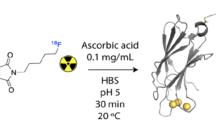Abstract.
The cellular distribution and processing pathways of two platinum compounds, modeling the antitumor drug cisplatin (cDDP) in human osteosarcoma (U2-OS) cells is reported. A [Pt(en)Cl2] entity has been covalently linked to a carboxyfluorescein diacetate (CFDA) moiety and to a dinitrophenyl (DNP) moiety. The two different constructs were administered to living cell cultures that were analyzed using digital fluorescence microscopy. The non-fluorescent CFDA construct becomes fluorescent after cellular uptake and subsequent acetate hydrolysis by esterases, and is therefore suitable to monitor platinum in living cells; the DNP construct can be visualized by immunocytochemistry and consequently serves as a control. Both complexes were readily internalized by the cells, and localized throughout the whole cell. After 2–3 h the complex accumulated in the nucleus, but 6–8 h after incubation a punctuate staining of a cytoplasmic region was observed, that persisted and became more pronounced after 24 h. The overall fluorescence in the cell decreased over time, implying a secretion of the platinum complex. Surprisingly, the accumulation remained visible after 72 h. Co-localization experiments with a Golgi apparatus-selective stain indicate the involvement of Golgi vesicles in intracellular processing of cisplatin-derived complexes. Immunocytochemical studies, using the DNP derivative, resulted in very similar images as obtained with the CFDA construct. CFDA-boc (a non-platinum-containing fluorescein derivative) was used as control: a faint staining throughout the whole cell was observed. Cisplatin-resistant U2-OS/Pt cells showed staining patterns very similar to the U2-OS cells using both platinum constructs. This study illustrates that only a very small portion of the platinum complex eventually remains bound to DNA, as after 24 h no significant fluorescence could be observed in the nucleus. Cisplatin-derived complexes with fluorescent tags afford a new insight into the cellular processing of these complexes and therefore may contribute to further unraveling of the mechanism of platinum antitumor complexes.
Similar content being viewed by others
Author information
Authors and Affiliations
Additional information
Electronic Publication
Rights and permissions
About this article
Cite this article
Molenaar, C., Teuben, JM., Heetebrij, R. et al. New insights in the cellular processing of platinum antitumor compounds, using fluorophore-labeled platinum complexes and digital fluorescence microscopy. J. Biol. Inorg. Chem. 5, 655–665 (2000). https://doi.org/10.1007/s007750000153
Received:
Accepted:
Issue Date:
DOI: https://doi.org/10.1007/s007750000153




